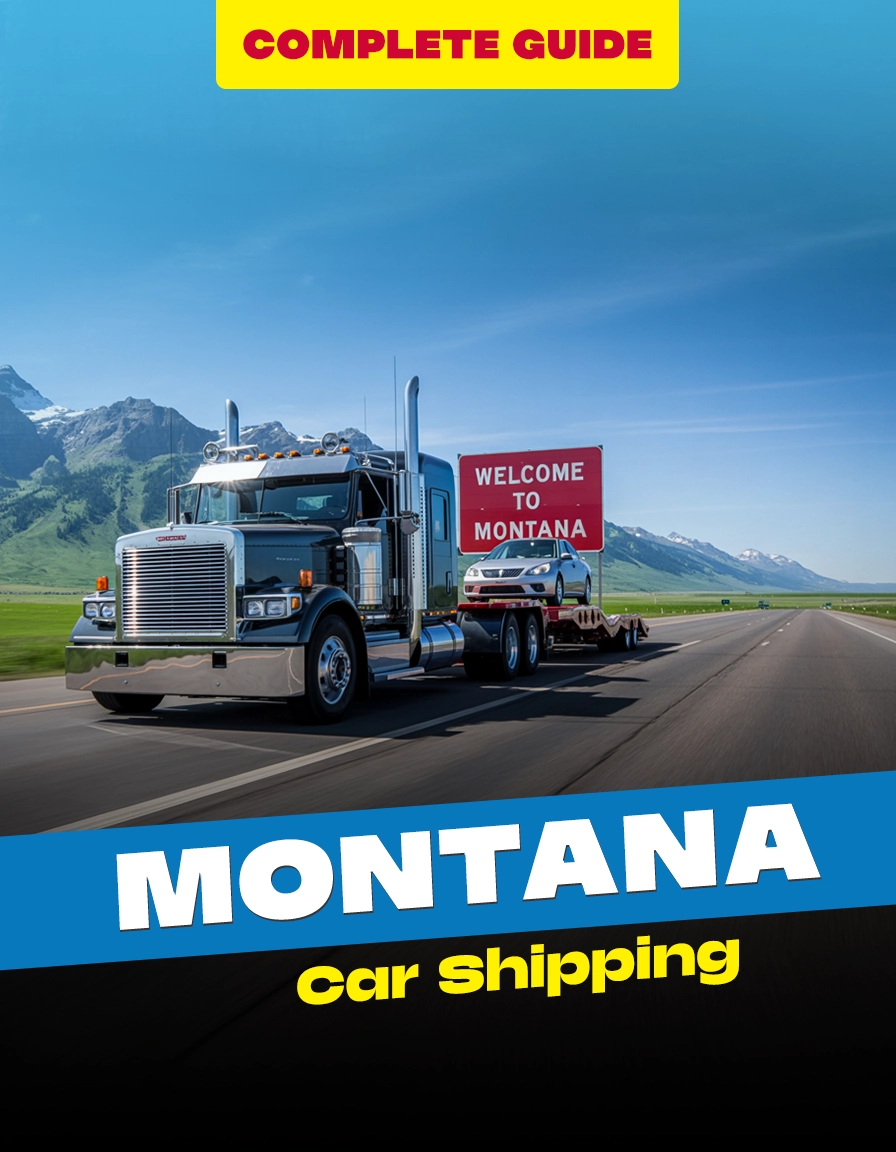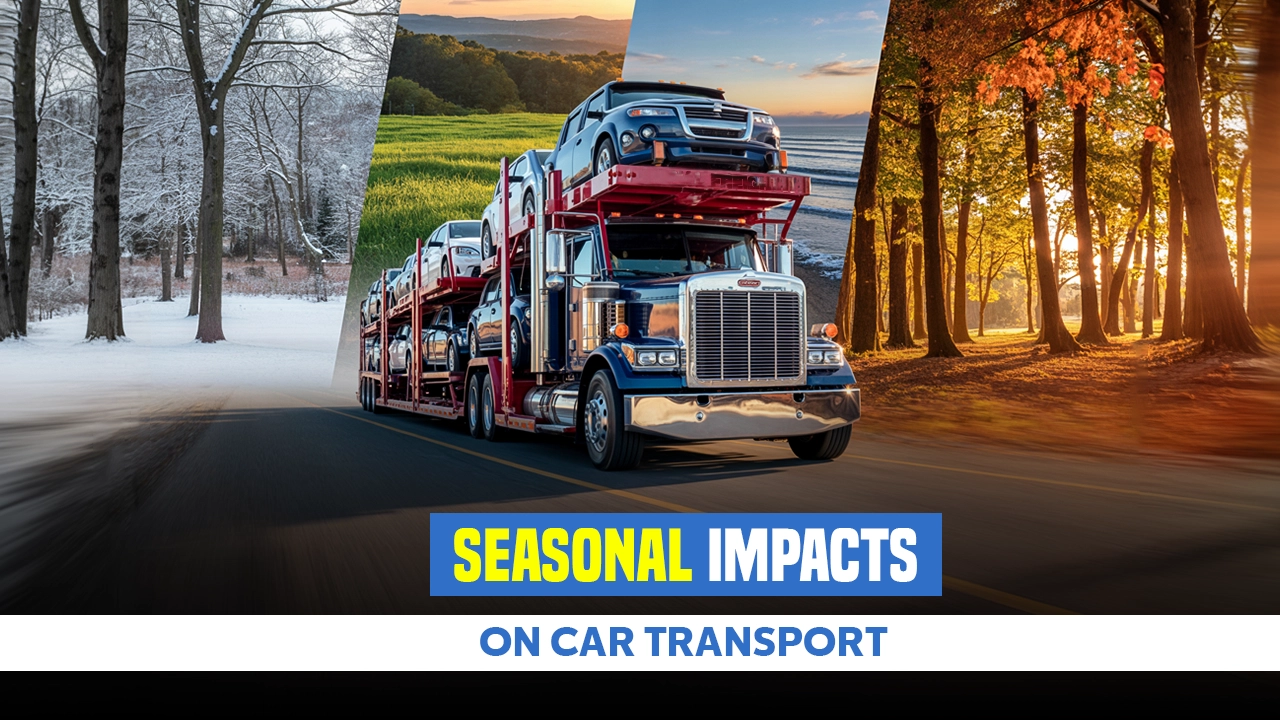Navigating Montana Car Shipping: Costs, Key Routes & Recommended Companies
Make Montana Car Shipping Process Easy
If you’re looking to ship a car to or from Montana, there are a few things you’ll want to know before you get started. At A4 Auto Transport we specialize in providing helpful information and guidance for people who take car shipping services. While Montana’s rural roads and changing weather can bring some challenges, we’ve helped many customers navigate them smoothly by choosing the right routes and working with a reliable auto transport company.


Top Auto Transport Company for Montana Roads

AutoStar Transport Express
Key Steps for Shipping Your Car To/From Montana
Request and Compare Quotes
Start by gathering quotes from 3-5 carriers or brokers at least 2-3 weeks before your shipping date. Properly compare what each quote includes. Learn how to obtain and compare car shipping quotes .
Pick a Company Familiar with Montana Roads
Montana has everything from wide interstate highways to steep mountain passes and long gravel roads. Choose a licensed, insured company with experience in cities like Billings, Missoula, and Great Falls.
Book Your Shipment the Right Way
Once you choose a company, they will assign a carrier and confirm pickup dates. Most reputable businesses do not require full payment until a truck is secured.
Gather Your Paperwork
Keep your documents ready before pickup to avoid delays. These include your vehicle title if requested, current registration, a valid photo ID, and the Bill of Lading that the carrier provides. Check out what documents do you need to ship a car!.
Prepare Your Vehicle for Montana’s Conditions
Wash your car so any existing damage is easy to see. Remove all personal belongings, especially anything that could shift during long rural drives. Make sure the car runs well, tires are inflated, and fluids are topped off.
Be Ready for Pickup and Delivery
If you live in a rural or hard-to-reach location, you may need to meet the carrier in a nearby town with better road access. Stay in touch with the driver since weather changes quickly in Montana and can affect timing.
Inspect Your Car at Delivery
Before signing the Bill of Lading, walk around the car and compare it to your photos from before shipping. If you notice any differences, note them immediately. Consider exploring ways to ship a car.
Popular State-to-State Auto Shipping Routes Involving Montana
Here are the most common state-to-state Montana car shipping routes and what you can expect in terms of cost, carriers, and transit time.
Note: We highly recommend going through all these key details before you plan to ship your car to and from Montana to any other state.
Shipping your vehicle between Montana and Florida means preparing for long distances and seasonal demand spikes. Knowing the route details and timing can help you avoid delays.
Moving a car from Florida to Montana involves planning around seasonal weather and limited carrier availability. Understanding key factors ensures a smoother transport experience.
Montana to Texas routes often see higher demand due to military and college moves. Being aware of these trends helps you plan your shipping schedule better.
Shipping from Texas to Montana requires flexibility with seasonal surges and rural delivery logistics. Early booking and route knowledge are essential for a hassle-free move.
Car shipments between Montana and California must consider mountain passes and weather conditions. Choosing the right carrier and timing can safeguard your vehicle during transit.
When shipping from California to Montana, wildfire season and regulatory requirements can impact schedules. Staying informed helps you avoid unexpected delays.
Montana to New York car transport covers a vast distance with urban delivery challenges. Planning ahead and understanding route specifics ensures a smoother process.
Shipping a car from New York to Montana involves navigating busy city regulations and rural Montana pickups. Proper preparation can simplify the journey.
Montana to Pennsylvania shipments cross multiple states and weather zones. Knowing seasonal impacts and route logistics helps optimize timing and cost.
Transporting cars from Pennsylvania to Montana requires careful consideration of routes that pass through mountainous areas, as access can be limited by terrain challenges.
Disclaimer: The prices and delivery times are estimates and may vary based on different factors.
Montana Car Shipping Costs and Transit Times
We understand how costs and transit times vary widely depending on distance, transport type, and route complexity. The table below outlines typical price ranges and delivery estimates to help you plan your shipment with confidence.
| Route Category | Distance Range (miles) | Carrier Type | Cost Estimate (USD) | Average Transit Time |
|---|---|---|---|---|
| Local Transport (Within Montana) | 0 – 150 | Open Carrier | $250 – $500 | 1 to 2 days |
| Intra-State (Across Montana) | 150 – 500 | Open Carrier | $500 – $800 | 1 to 3 days |
| Regional (To/From Neighboring States, e.g., ID, WY, ND, SD) | 500 – 900 | Open Carrier | $700 – $1,100 | 2 to 4 days |
| Mid-Distance (To/From States like TX, CO, AZ) | 900 – 1,500 | Open Carrier | $900 – $1,300 | 3 to 6 days |
| Cross-Country (To/From East Coast or Southeast) | 1,500 – 2,200 | Open or Enclosed Carrier | $1,200 – $1,700 | 5 to 8 days |
| Long-Distance Premium (To/From FL, NY, PA) | 2,200+ | Open or Enclosed Carrier | $1,400 – $2,000+ | 6 to 9 days |
Disclaimer:These prices and delivery times are estimates and may vary based on factors. Always request a personalized.
Key Factors Influencing Montana Car Shipping Costs
Below are some key factors that often get overlooked by Montana car shippers, but they can make a big difference in what you actually pay.
-
Vehicle Size and Weight Influence Overall Cost:
Bigger or heavier vehicles like trucks, SUVs, or RVs will cost more to ship across or from Montana. -
Limited Carrier Availability in Rural Areas Affects Scheduling and Price:
Fewer trucks operate routes through Montana, especially in places like Great Falls or Kalispell, increasing wait times and cost. -
Challenging Winter Weather Conditions Add to Transport Risk:
Snowstorms and icy roads make transport more hazardous in winter, leading to seasonal rate hikes and possible delays. -
Distance of Transport is a Key Factor:
Shipping to or from remote Montana towns over long distances adds significantly to the total cost. -
Transport Type (Open vs Enclosed) Impacts the Price:
Enclosed carriers offer better protection from Montana’s extreme weather but are more expensive than open transport. -
Sparse Population and Remote Locations Lead to Higher Fees:
Many Montana towns are isolated, meaning fewer carriers pass through, raising pickup and delivery charges. -
Scenic Routes and National Parks Slow Down Transit:
Transport around Yellowstone or Glacier National Park can involve detours or slower travel, increasing delivery times and costs.
Which Montana Cities Have the Highest Demand for Vehicle Shipping Services?
While the price ranges listed above provide a helpful estimate, not all good car shipping companies in Virginia will offer the exact same rates. Some may charge slightly more depending on the quality of service, experience, and added features.Here’s what you should keep in mind:
Billings
Largest city and key commercial hub with high inbound and outbound shipping activity
Missoula
University town with steady demand, especially during school seasons
Bozeman
A rapidly growing city with many relocations and seasonal vehicle shipments
Great Falls
Regional center supporting residents, military, and business transport needs
Helena
State capital with consistent government and commercial vehicle shipping
Kalispell
Near Glacier National Park, with seasonal spikes due to tourism and part-time residents
Unique Challenges You Have to Face for Montana Car Shipping
Below are some key factors that often get overlooked by Montana car shippers, but they can make a big difference in what you actually pay.
- Montana’s huge open spaces might sound peaceful, but they actually make it harder for carriers to reach certain areas, especially in the middle of nowhere.
- Winters here? They’re no joke. Snow, ice, and freezing temps can definitely slow things down.
- Some of the mountain roads are beautiful, but also narrow, winding, and tough for big transport trucks.
- Wildfire season in the summer can cause detours or sudden delays if roads close unexpectedly.
- If you’re looking for enclosed shipping in a rural area, options might be limited so it’s best to plan ahead.
- Spring and fall are super busy for moves in Montana, so you might face longer wait times during those seasons.
- Live in a small town or somewhere way off the main highway? Your driver might ask to meet somewhere more accessible.
- And of course, fuel prices are always changing, that can affect what you end up paying for your shipment.
What Are Montana DOT Regulations for Car Shipping Companies?
Shipping a car in Big Sky Country isn’t quite the same as in urban states. Montana’s wide-open highways, remote towns, and mountainous terrain all come with their own transport regulations that auto carriers must follow.
USDOT and MT Intrastate Authority
Carriers transporting vehicles within Montana need both federal USDOT numbers and Montana-specific intrastate operating authority from MDT.
CDL for Mountain Conditions
Drivers must hold a valid CDL and be trained for steep grades, switchbacks, and icy mountain passes like those on US-93 or MT-200.
Axle and Bridge Weight Limits
Montana enforces strict axle weight limits, especially on bridges in rural counties like Ravalli or Lincoln during spring thaw.
Seasonal Load Restrictions
During March to May, many counties (especially western Montana) impose reduced load limits due to thawing roadbeds — this can delay pickups.
Designated Vehicle Routes
Certain vehicles must avoid scenic byways such as Going-to-the-Sun Road in Glacier National Park, which prohibits large transport trucks entirely.
Permit-Only Travel on Certain Highways
Oversize carriers require special permits on roads like MT-3 or US-12 due to winding, narrow passages.
What Montana-Specific Car Shipping Laws Should You Know?
Montana doesn’t just expect carriers to follow national rules, the state has its own laws to protect customers and account for geographic challenges.
Written Contracts Required by Law
Montana state law requires all auto transport agreements to be documented in writing, including price, timeframe, pickup/delivery locations, and carrier responsibilities.
Damage Claims Policy
Montana requires auto transporters to respond to written damage claims within 30 days, and maintain inspection records in case of disputes.
Rural Delivery Responsibility
Carriers must make a reasonable effort to reach rural or ranch locations, but may ask customers to meet at highway junctions if access is unsafe.
Door-to-Door Cancellation Law
For non-terminal, door-to-door services, Montana residents have 24 hours to cancel with no penalty after signing.
Licensing for Brokers Serving Montana
Any broker arranging transport into or out of Montana must be bonded and licensed federally and able to demonstrate Montana route knowledge.
How Do Winter Weather Conditions in Montana Affect Car Shipping Times and Costs?
From years of tracking seasonal shipping patterns, we’ve seen that Montana winters are no joke. Snowstorms, black ice, and subzero temperatures regularly disrupt transit schedules. These extreme conditions often reduce the number of active carriers on the road and require additional precautions, which leads to higher costs and longer delivery windows, especially in December through March.
Tip from our experience: Work only with carriers who specialize in mountain-state routes and understand how to navigate icy mountain passes. It’s something we’ve advised countless clients, and it consistently results in fewer weather-related surprises.
Are There Special Permits Required for Shipping Cars in Montana’s Mountainous Areas?
Based on our direct coordination with Montana-based transport carriers, standard vehicles typically don’t need special permits even in steep or remote regions like the Rockies or Beartooth Highway. That said, we’ve handled cases involving larger vehicles such as RVs, lifted trucks, and equipment haulers where extra permits were required due to weight or width restrictions on mountainous roads.
How Far in Advance Should You Book Montana Car Shipping During Peak Seasons?
Here’s what our data and customer trends show. Montana’s car shipping demand spikes during spring April to June and fall September to October, especially among college students, military personnel, and snowbirds. During these windows, we strongly recommend booking three to six weeks in advance to lock in a fair rate and preferred schedule.
Too many customers wait until the last minute only to face limited carrier availability or inflated prices. Planning ahead, especially in a rural-heavy state like Montana, gives you better options and smoother delivery.
What Should You Expect on Your Car Shipping Bill When Shipping to or from Montana?
When shipping a car to or from Montana, your bill will include the base shipping cost plus any extra fees for services like remote pickups or expedited delivery. It’s important to know the methods for paying car shipping bills, as most Montana car shipping companies take credit cards, bank transfers, and sometimes checks. Make sure to clarify payment terms upfront to avoid surprises and ensure a smooth transaction.
How Far in Advance Should You Book Montana Car Shipping During Peak Seasons?
One of the most popular and cost-effective options for transporting vehicles in Montana is open carrier car shipping . It works well for most everyday cars, trucks, and SUVs, especially during milder seasons.
However, given Montana’s unpredictable weather and rugged terrain, open transport may expose vehicles to snow, road debris, and dust. For those concerns, especially in winter or for high-value vehicles, enclosed transport might be a better choice. Overall, open car shipping offers great value for Montana residents looking for affordable and reliable vehicle transport.
Can You Ship Your Non-Running Vehicle Within Montana or To/From Montana?
Yes, you can ship non-running vehicles within Montana or to and from the state. However, transporting a non-operational car requires specialized equipment such as flatbed trailers or winch systems, which can increase the cost. It’s important to notify your car shipping company in advance so they can prepare the appropriate carrier and handle the vehicle safely.
What Safety Measures Do Montana Car Shipping Companies Take for Winter Transport?
- Use of enclosed carriers to protect vehicles from snow, ice, and road salt.
- Employing drivers experienced in navigating icy and mountainous roads.
- Scheduling flexible pickup and delivery times to avoid severe weather conditions.
- Regularly inspecting and maintaining trucks to ensure safe winter operation.
- Providing additional insurance options to cover weather-related risks.
How Do Remote Montana Locations Impact Car Shipping Availability and Pricing?
Remote Montana locations can limit carrier availability, leading to fewer transport options and longer wait times. This often results in higher shipping costs due to increased travel distances, specialized equipment needs, and logistical challenges accessing rural or mountainous areas. Planning ahead and booking early can help secure better rates and reliable service in these locations.
How Do Seasonal Changes Affect Montana Car Shipping?
- Winter weather with snow and ice can delay shipments and raise costs due to safety measures.
- Limited carrier availability during harsh winter months may increase wait times.
- Spring and fall see higher demand from relocations and seasonal moves, leading to possible price hikes.
- Summer offers better road conditions and quicker transit times but can be impacted by wildfires.
- Planning shipments according to seasonal patterns helps reduce delays and control costs.

What Paperwork Is Required for Shipping a Car From Montana?
- Valid government-issued photo ID (e.g., Montana driver’s license)
- Vehicle title (especially important for out-of-state shipments or ownership transfer)
- Vehicle registration to prove legal ownership and current registration status
- Proof of insurance (some Montana carriers may request this, even if they provide coverage)
- Bill of Lading is provided by the carrier at pickup as the official transport agreement
- Lienholder authorization if the vehicle is leased or financed
Recommended Car Shipping Companies for Montana
We’ve researched the top auto transport companies, and based on that research, we confidently recommend AutoStar Transport Express:
AutoStar Transport Express

AutoStar Transport Express leads the Montana car shipping market with unmatched reliability, top-tier customer service, and flexible transport solutions. Their transparent pricing sets them apart as the top choice.
We highlight AutoStar Transport Express as our top recommended company. Other companies are kept anonymous. Always request multiple quotes to compare services and pricing.
Conclusion
When it comes to reliable Montana car transport, understanding the unique challenges, costs, and routes is key to a smooth experience. Whether you’re shipping within Montana or across state lines, choosing experienced carriers familiar with the terrain ensures your vehicle’s safety. Plan ahead, consider seasonal factors, and prepare the necessary paperwork to make your Montana car shipping hassle-free and efficient.
FAQs
Can I pack personal items in my car during Montana car shipping?
Are there specific types of vehicles that require special handling when shipping in Montana?
Do I need to be present when my car is picked up or delivered in Montana?
What’s the difference between terminal-to-terminal and door-to-door car shipping in Montana?
How do I verify that a Montana car shipping company is licensed and insured?

a4AutoTransport is a group of auto transport researchers and experts that comes in handy for anyone who wants to move their car/vehicle without putting extra miles on the odometer. At a4AutoTransport, We researched over a hundred car shipping companies, interviewed real customers and industry leaders, and collected nearly 500 quotes to find the nation’s best auto transport companies. With our combined 5 years of industry experience and research, we’ll help you find the right car shipper for your budget.
